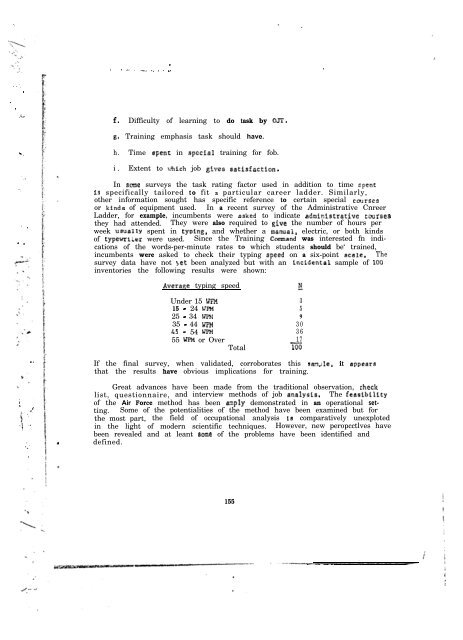Technical Report - International Military Testing Association
Technical Report - International Military Testing Association
Technical Report - International Military Testing Association
Create successful ePaper yourself
Turn your PDF publications into a flip-book with our unique Google optimized e-Paper software.
‘.<br />
. . ‘.<br />
.<br />
.<br />
.<br />
.i,<br />
.<br />
-,<br />
‘..<br />
‘,.<br />
‘. .<br />
- -<br />
-.<br />
i I. ,,<br />
i ,*<br />
.\ 1.<br />
.<br />
-_'<br />
1(<br />
.<br />
.<br />
j , _<br />
.<br />
_. * 1 I., ..-. _.<br />
f. Difficulty of learning to do task by OJT.<br />
g. Training emphasis task should have.<br />
h. Time apent in ~pccinl training for fob.<br />
i. Extent to t.hich job give& satisfac:ion.<br />
In Borne surveys the task rating factor used in addition to time spent<br />
is specifically tailored to fit s particular career ladder. Similarly,<br />
other information sought has specific reference to certain special coI>rscs<br />
or kinds of equipment used. In a recent survey of the Administrative Cnreer<br />
Ladder, for example, incumbents were asked to indicate admlnlstrativc ccurBe8<br />
they had attended. They were also required to gfve the number of hours per<br />
week usually spent in typing, and whether a menuai, electric, or both kinds<br />
of typewrlirr were used. Since the Training C-and was interested fn indications<br />
of the words-per-minute rates to which students should be‘ trained,<br />
incumbents were asked to check their typing speed on a six-point scale. The<br />
survey data have not let been analyzed but with an fntidental sample of 105<br />
inventories the following results were shown:<br />
AveraRe typing speed<br />
Under 15 W!?X 3<br />
15 - 24 wF?4 5<br />
25 - 34 WE4 9<br />
35 - 44 WFM 30<br />
.45 ” 54 WFM 36<br />
55 WPM or Over 17<br />
Total 100<br />
If the final survey, when validated, corroborates this am;le, it appeara<br />
that the results have obvious implications for training.<br />
Great advances have been made from the traditional observation, check<br />
list, questionnaire, and interview methods of job analyrris. The feastbility<br />
of the Air Force method has been azmply demonstrated in an operational setting.<br />
Some of the potentialities of the method have been examined but for<br />
the most part, the field of occupational analysis is comparatively unexploted<br />
in the light of modern scientific techniques. However, new peropcctlves have<br />
been revealed and at leant Borne of the problems have been identified and<br />
defined.<br />
155









